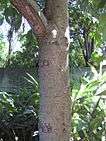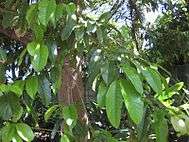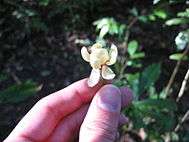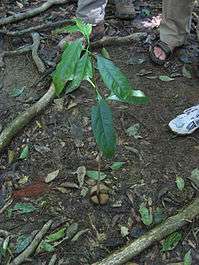Idiospermum
Idiospermum is a genus containing a single species of tree, Idiospermum australiense, found in Australian tropical rainforests. The species represents one of the earliest known lineages of flowering plants, dating back as far as 120 million years. It is found today only in the Daintree and Wet Tropics rainforests region of north-eastern Queensland. It is endemic to a very few locations in north-eastern Queensland (e.g. in Daintree National Park), in the very wet lowland parts of the forest, in groups of 10–100 trees together (rather than scattered individuals). Common names include ribbonwood and idiot fruit (Hyland et al. 2010).
| Idiospermum | |
|---|---|
 | |
| Habit in cultivation | |
| Scientific classification | |
| Kingdom: | Plantae |
| Clade: | Tracheophytes |
| Clade: | Angiosperms |
| Clade: | Magnoliids |
| Order: | Laurales |
| Family: | Calycanthaceae |
| Genus: | Idiospermum S.T.Blake |
| Species: | I. australiense |
| Binomial name | |
| Idiospermum australiense (Diels) S.T.Blake | |
Description
Ribbonwood trees grow naturally in their wet tropical rainforest habitats as evergreens up to about 20–40 m (70–130 ft) tall and about 90 cm (35 in) in diameter at breast height (DBH). The simple leaves grow singly, in pairs or in whorls of 3–4, each one measuring about 12–25 cm (5–10 in) long and 5–9 cm (2.0–3.5 in) wide. The flowers measure 4–5 cm (1.6–2.0 in) in diameter, with all floral organs spirally arranged (Staedler, Weston & Endress 2007). The tepals are initially creamy white when the flower opens, then turn red as the flower ages. The "fruits" have very distinctive features and do not fit within the definition of true fruits as such: all the protective layers decay while still on the parent tree and each one released is an extremely large (8 cm (3.1 in) diameter) naked plant embryo (Staedler, Weston & Endress 2009). This is one of the very largest embryos in flowering plants. It is very toxic, inducing symptoms (in cattle) similar to strychnine (Hyland et al. 2010).




Reproductive organs
Plants have both male and female sex organs, but half of the flowers of the Ribbonwood do not produce any fertile female organs (Staedler, Weston & Endress 2009). Attracted by the scent and colour of the flower, small beetles and thrips are the main floral visitors (Worboys & Jackes 2005); they crawl in and lay their eggs within the center of the flower, which contains the flower's pollen. Within the flower some of the sticky pollen gets trapped on the insect's bodies, and if the next flower they visit is a receptive one, it will pollinate and produce the seeds. While most modern flowering plants produce seeds which have one cotyledon (monocotyledons) or two (dicotyledons), the seedlings of the Ribbonwood have between two and five cotyledons. Also the Ribbonwood can produce more than one shoot per seed (usually one per cotyledon). I. australiense is the only known species in which the flowers display a continuous spiral series of bracts, sepals, petals, stamens and finally staminodes.
Seeds and their dispersal ecology
The seeds are currently mainly spread through gravity dispersal, the seeds rolling down the steep mountain slopes to find their new home. The seeds are so toxic that most animals cannot eat them without being severely poisoned; however it is known that the native Musky Rat-kangaroo does disperse and bury some of these seeds. It has been suggested that the seeds were formerly dispersed by the now-extinct Diprotodon, on the basis that many Australian marsupials are adapted to cope with the toxins in Australian plants.
The plants have adapted a unique poison, a chemical called Idiospermuline contained within the seed, to prevent animals eating them. Researchers discovered the poison affects transmission of messages between individual nerve cells, which may cause seizures. In small doses this chemical can be used to save lives.
Scientific recognition
The first European-Australians to recognise the trees were timber cutters south of Cairns in the late 1800s. It was thought to have become extinct, but was later brought to the attention of the German botanist Ludwig Diels, who in 1902 described the species in the genus Calycanthus as C. australiense, a remarkable disjunction for this otherwise North American genus. It was later believed to be extinct again, because when Diels finally returned to the location where this tree was found, the natural vegetation had been destroyed for a sugar cane farm.
In 1971, John Nicholas, a Daintree grazier, believing someone to be poisoning his cattle, called in the police. A government veterinarian, Doug Clague, discovered in the cows’ stomachs relatively intact Idiospermum seeds that had been swallowed whole. Curious about this seed’s ability to completely knock cattle dead—after first causing spasms and paralysing the nerves—he sent specimens off to the Queensland Herbarium saying he had made the botanical discovery of the century.
References
- Staedler, Yannick M.; Weston, Peter H.; Endress, Peter K. (2007). "Floral phyllotaxis and floral architecture in Calycanthaceae (Laurales)". International Journal of Plant Sciences. 168 (3): 285–306. doi:10.1086/510417.CS1 maint: ref=harv (link)
- Staedler, Yannick M.; Weston, Peter H.; Endress, Peter K. (2009). "Comparative Gynoecium structure and development in Calycanthaceae (Laurales)" (PDF). International Journal of Plant Sciences. 170 (1): 21–41. doi:10.1086/593045.CS1 maint: ref=harv (link)
- Worboys, Stuart J.; Jackes, Betsy R. (2005). "Pollination processes in Idiospermum australiense (Calycanthaceae), an arborescent basal angiosperm of Australia's tropical rain forests". Plant Systematics and Evolution. 251 (2–4): 107–117. doi:10.1007/s00606-004-0226-z.CS1 maint: ref=harv (link)
- Hyland, B. P. M.; Whiffin, T.; Zich, F. A.; et al. (Dec 2010). "Factsheet – Idiospermum australiense". Australian Tropical Rainforest Plants (6.1, online version RFK 6.1 ed.). Cairns, Australia: Commonwealth Scientific and Industrial Research Organisation (CSIRO), through its Division of Plant Industry; the Centre for Australian National Biodiversity Research; the Australian Tropical Herbarium, James Cook University. Retrieved 4 Jan 2014.CS1 maint: ref=harv (link)
External links
- The families of flowering plants: Descriptions, illustrations, identification, information retrieval by L. Watson and M. J. Dallwitz
- The story of the rediscovery of Idiospermum by Prue Hewett
- An update of the Angiosperm Phylogeny Group classification for the orders and families of flowering plants: APG II by the Angiosperm Phylogeny Group
- The Australian Geographic Story of the Idiot Tree Plant